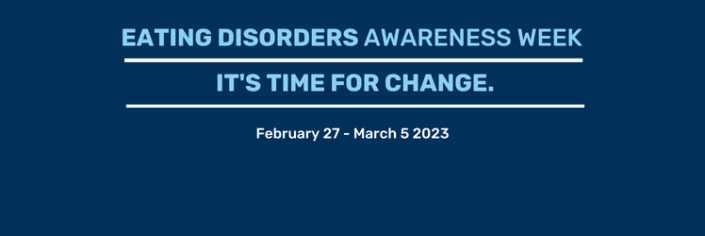It is important to have awareness of disordered eating behaviors (including dieting) because they can be precursors to eating disorders. Disordered eating may include (and is not limited to) a rigid food and exercise regime; feelings of guilt or shame when unable to maintain said regime; a preoccupation with food, body, and exercise that has an impact on quality of life; compulsive eating; compensatory measures to ‘make up for’ food consumed (i.e.: excessive exercise, food restriction, fasting, purging, and laxative or diuretic use); and weight loss supplement use. Checking-in with intentions behind and behaviors around food and exercise may be helpful in determining if it is an unhealthy relationship. Eating disorders may include the behaviors mentioned but they are complex psychiatric illnesses with biological components and they can be life-threatening. Eating disorders are 50-80% genetically based — they are not a choice.
When an individual is struggling with an eating disorder, they generally engage in multiple behaviors with more frequency and intensity. The level of obsession with food, exercise, and body thoughts and behaviors can distinguish disordered eating from an eating disorder. These thoughts are generally all-consuming and may include (but are not limited to) fixation on calories; good and bad foods; ingredients; measurement; taste; body size and shape; type and frequency of exercise; feelings of failure when unable to sustain these behaviors; and avoidance of social activities. Many of us are familiar with Anorexia, Bulimia, and Binge Eating Disorder (BED).
While awareness of “typical” signs/symptoms of the more “familiar” eating disorders is critical, it is also important to note that there is a spectrum of maladaptive behaviors (some close to becoming official diagnoses and some not close enough), and that disordered eating and eating disorder symptoms can manifest at different times and overlap. It is also vital to have an understanding that eating disorders come in all shapes and sizes, they do not discriminate between age; gender; race; class; sexual orientation and ethnic groups, and you cannot tell if someone is struggling on the basis of appearance.
This list is intended as a general overview of signs that may indicate a serious problem:
- Behaviors and attitudes that indicate that weight loss, dieting, and control of food and food rituals are becoming primary concerns
- Limited range of preferred foods that become narrower over time (i.e.: picky eating that progressively worsens)
- Cutting out an increasing number of food groups (all sugar, all carbs, all dairy, all meat, all animal products)
- An increase in concern about the health of ingredients; an inability to eat anything but a narrow group of foods that are deemed ‘clean,’ ‘healthy,’ or ‘pure’
- Self-esteem overly related to body image
- Extreme concern with body size and shape
- Expresses a need to “burn off” calories taken in
- Maintains an excessive, rigid exercise regime – despite weather, fatigue, illness, or injury
- Intense anxiety, depression and/or distress if unable to exercise
- Dry skin and hair, and brittle nails
- Fine hair on body (lanugo)
- Muscle weakness
- Poor wound healing
- Difficulties concentrating
- Feeling cold all the time
- Noticeable fluctuations in weight, both down and up
- Feelings of disgust, depression, or guilt after eating, and/or feelings of low self-esteem
- Evidence of binge eating, including the disappearance of large amounts of food in short periods of time; feeling lack of control over the ability to stop eating. Sometimes including behaviors to prevent weight gain, such as self-induced vomiting, use of laxatives/diuretics, or excessive exercise.
- Cuts and calluses across the top of finger joints and dental problems such as enamel erosion (a result of inducing vomiting)
- Swelling around the area of salivary glands
- Withdrawal from usual friends and activities
If this list causes any level of concern, or thoughts about food, weight, exercise routine, body shape or size are taking a predominant role, seeking professional help for early detection is strongly encouraged. A study by the National Association of Anorexia Nervosa and Associated Disorders reported that Anorexia Nervosa has the highest death rate of any psychiatric illness (including major depression). Without treatment, up to 20% of people with serious eating disorders die. With treatment though, the mortality rate falls to 2-3%.
It is challenging to trust that our bodies will tell us what is needed for nourishment and movement… we just need encouragement and courage to disengage with the external messages and to reconnect with ourselves. Eating and moving without the influence of culture and others, while making reasonable health choices and embracing body diversity, will help us with body acceptance, overall wellness, and the prevention of maladaptive behaviors. Increasing awareness, addressing the stigma and bias, and working to eliminate shame will help bring us even closer to the prevention of eating disorders.
NEDA offers an online screening tool to help determine if it is time to seek support: https://www.nationaleatingdisorders.org/screening-tool.
For recovery resources and treatment options, please visit our resource center. If you or someone you know is struggling with an eating disorder, call ANAD’s Helpline at: (888) 375-7767 or the National Alliance of Eating Disorders Helpline at: (866) 662-1235.
If you are thinking about suicide, call or text the National Suicide Prevention Lifeline at 988. In crisis situations, text “NEDA” to 741741 to be connected with a trained volunteer from the Crisis Text Line.
Simone’s professional expertise spans marketing, as well as small business, event, project and nonprofit management. Her passions for collaboration and building strong relationships, combined with her personal history of disordered eating, drive Simone to make a difference as the Executive Director for Carolina Resource Center for Eating Disorders. Carolina Resource Center for Eating Disorders (CRC for ED) is the only nonprofit in NC supporting individuals, families, and professionals concerned with disordered eating and recovery from eating disorders.






